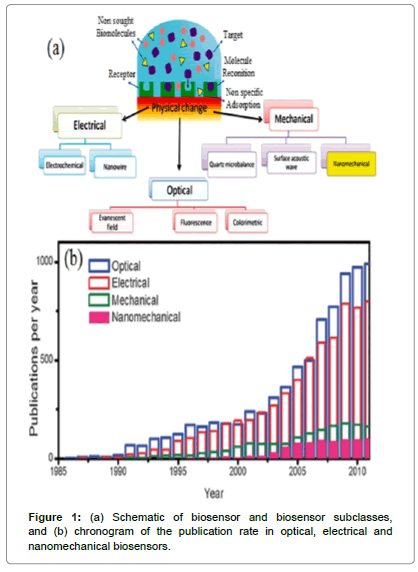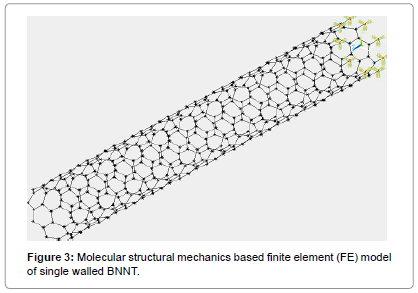Short Communication Open Access
Boron Nitride Nanotube as a Nano-mechanical Biosensor: A Computational Approach
Mitesh B. Panchal*
Department Mechanical Engineering, Nirma University, Ahmedabad, India
- Corresponding Author:
- Panchal MB
Department Mechanical Engineering, Institute of Technology
Nirma University, Sarkhej-Gandhinagar Hwy
Ahmedabad 382481, Gujarat, India
Tel: +91-079-30642242
E-mail: mitesh.panchal@nirmauni.ac.in
Received Date: May 21, 2015 Accepted Date: July 30, 2015 Published Date: August 01, 2015
Citation: Panchal MB (2015) Boron Nitride Nanotube as a Nano-mechanical Biosensor: A Computational Approach. Biosens J 4:118. doi:10.4172/2090-4967.1000118
Copyright: © 2015 Panchal MB. This is an open-access article distributed under the terms of the Creative Commons Attribution License, which permits unrestricted use, distribution, and reproduction in any medium, provided the original author and source are credited.
Visit for more related articles at Biosensors Journal
Short Communication
The nanostructures based biosensors are increasingly in demanded for fundamental biological studied, health conditioning, drug delivery and clinical diagnosis [1-3]. Based on the nature of the transduction signal, biosensors can be classified into optical, electrical and mechanical [4]. In mechanical biosensors, the resonance frequency is measured and related to estimate the mass change due to the binding of the additional element on the sensor surface. Nanomechanical biosensor is a subclass of mechanical biosensors, which is having size of nanoscale at least in one of their dimensions [5,6].
The nanostructures based biosensors are increasingly in demanded for fundamental biological studied, health conditioning, drug delivery and clinical diagnosis [1-3]. Based on the nature of the transduction signal, biosensors can be classified into optical, electrical and mechanical [4]. In mechanical biosensors, the resonance frequency is measured and related to estimate the mass change due to the binding of the additional element on the sensor surface. Nanomechanical biosensor is a subclass of mechanical biosensors, which is having size of nanoscale at least in one of their dimensions [5,6].
The higher value of Young's modulus (similar to the CNTs) of BNNTs make them superior chemically and thermally stable materials [9]. The excellent piezoelectric properties make them superior to those of piezoelectric polymers [9]. Such properties furnish BNNT as a potential material for a wide range of applications in the field of nanoscience and nanotechnology [10-12] (Figures 2 and 3).
The resonant frequency variation based analysis suggests the possible mass sensitivity limit of 10-8 fg can be achieved using BNNT as nanoresonators [10,12,13]. The molecular structural mechanics based simulation approach can be effectively utilized to model the different atomistic finite element (FE) model BNNTs like, zigzag, armchair, chiral, pristine and defective [11,14-17].
The resonant behavior of almost all types of possible atomic structures of nanotubes suggests, the possible detection of masses of nano-scale level like acetone molecules, biological objects like DNA components, bacterium/viruses, etc. [17-19]. The structural molecular mechanics based resonant frequency based analysis may be useful to practically realize the future BNNT based biosensor systems for the real time detection of biological objects and chemical molecules for the future health monitoring. Also, using multiphysics approach, a more robust sensor systems using BNNTs can be proposed to incorporate the piezoelectric properties along with their vibrational characteristics.
The binding energy of the different biological objects or the chemical molecules of nano-scale mass can be enhanced using dopants in the base atomic structure of the BNNTs to enhance the capabilities of BNNT based biosensor systems.
References
- D’Orazio P (2011) Biosensors in clinical chemistry. Clin. Chim. Acta. 334:41-69.
- Tothill IE (2009) Biosensors for cancer markers diagnosis. Semin Cell Dev Biol. 20:55-62.
- Justino CIL, Rocha-Santos TA, Duarte AC (2010) Review of analytical figures of merit of sensors and biosensors in clinical applications. TrAC Trends Anal. Chem. 29: 1172-1183.
- Tamayo J, Kosaka PM, Ruz JJ, Paulo AS, Calleja M (2013) Biosensors based on nanomechanical systems. ChemSoc Rev. 42:1287-1311.
- Arlett J, Myers E, Roukes M (2011) Comparative advantages of mechanical biosensors. Nat Nanotechnol. 6:203-215.
- Boisen A, Thundat T (2009) Design & fabrication of canti-lever array biosensorsMate. Today. 12:32-38.
- Hansen KM, ThundatT(2005) Microcantilever biosensors.Methods 37:57-64.
- Goeders KM, Colton JS, Bottomley LA (2008) Micro-cantilevers: sensing chemical interactions via mechanical motion. Chem. Rev. 108:522-542.
- Hood L, Heath JR, Phelps ME, Lin B (2004) Systems biology and new technologies enable predictive and preventative medicine. Science. 306:640-643.
- Panchal MB, UpadhyaySH, Harsha SP (2012) Vibration Analysis of Single Walled Boron Nitride Nanotube Based Nanoresonators. J. Nanotechnol. Eng. Med. 3:1-5.
- Panchal MB, Upadhyay SH, Harsha SP (2013) Cantilevered Single Walled Boron Nitride Nanotube Based Nanomechanical Resonators of Zigzag and Armchair Forms. Physica E 50:73-82.
- Panchal MB Upadhyay SH (2013) Clamped-Clamped Single Walled Boron Nitride Nanotube Based Resonant Nanomechanical Mass Sensors. Journal of Mechatronics 1:93-99.
- Panchal MB,Upadhyay SH (2013) Vibrational Characteristics of Defective Single Walled BN Nanotube Based Nanomechanical Mass Sensors: Extended Defect or Dislocation Line. Sensors and Actuators A: Physical 203:160-167.
- Panchal MB, Upadhyay SH (2013) Effect of Chirality on Resonant Behavior of Single Walled BN Nanotube Based Nanomechanical Resonator. Current Nanoscience. 9:525-531.
- Panchal MB, Upadhyay SH,Harsha SP (2013)Vibrational Characteristics of Defective Single Walled BN Nanotube Based Nanomechanical Mass Sensors: Single Atom Vacancies and Divacancies. Sensors and Actuators A: Physcial 197:111-121.
- Panchal MB,Upadhyay SH (2013) Vibrational Analysis of Zigzag and Armchair Fixed Free Single Walled Boron Nitride Nanotubes: Atomistic Modeling Approach. Current Nanoscience. 9:254-261.
- Panchal MB,Upadhyay SH (2014) Boron Nitride Nanotube Based Biosensor For Acetone Detection: Molecular Structural Mechanics Based Simulation. Molecular Simulation 40:1035-1042.
- Panchal MB,Upadhyay SH (2014) Boron Nitride Nanotube Based Biosensing of Various Bacterium/Viruses: Continuum Modeling Based Simulation Approach. IET Nanobiotechnology 8:143-148.
- Panchal MB, Upadhyay SH (2014) Single Walled Boron Nitride Nanotube Based Biosensor: An Atomistic Finite Element Modeling Approach. IET Nanobiotechnology 8:149-156.
Relevant Topics
- Amperometric Biosensors
- Biomedical Sensor
- Bioreceptors
- Biosensors Application
- Biosensors Companies and Market Analysis
- Biotransducer
- Chemical Sensors
- Colorimetric Biosensors
- DNA Biosensors
- Electrochemical Biosensors
- Glucose Biosensors
- Graphene Biosensors
- Imaging Sensors
- Microbial Biosensors
- Nucleic Acid Interactions
- Optical Biosensor
- Piezo Electric Sensor
- Potentiometric Biosensors
- Surface Attachment of the Biological Elements
- Surface Plasmon Resonance
- Transducers
Recommended Journals
Article Tools
Article Usage
- Total views: 12099
- [From(publication date):
specialissue-2015 - Jul 13, 2025] - Breakdown by view type
- HTML page views : 11065
- PDF downloads : 1034



